Asus 2014 Annual Report Download - page 251
Download and view the complete annual report
Please find page 251 of the 2014 Asus annual report below. You can navigate through the pages in the report by either clicking on the pages listed below, or by using the keyword search tool below to find specific information within the annual report.-
 1
1 -
 2
2 -
 3
3 -
 4
4 -
 5
5 -
 6
6 -
 7
7 -
 8
8 -
 9
9 -
 10
10 -
 11
11 -
 12
12 -
 13
13 -
 14
14 -
 15
15 -
 16
16 -
 17
17 -
 18
18 -
 19
19 -
 20
20 -
 21
21 -
 22
22 -
 23
23 -
 24
24 -
 25
25 -
 26
26 -
 27
27 -
 28
28 -
 29
29 -
 30
30 -
 31
31 -
 32
32 -
 33
33 -
 34
34 -
 35
35 -
 36
36 -
 37
37 -
 38
38 -
 39
39 -
 40
40 -
 41
41 -
 42
42 -
 43
43 -
 44
44 -
 45
45 -
 46
46 -
 47
47 -
 48
48 -
 49
49 -
 50
50 -
 51
51 -
 52
52 -
 53
53 -
 54
54 -
 55
55 -
 56
56 -
 57
57 -
 58
58 -
 59
59 -
 60
60 -
 61
61 -
 62
62 -
 63
63 -
 64
64 -
 65
65 -
 66
66 -
 67
67 -
 68
68 -
 69
69 -
 70
70 -
 71
71 -
 72
72 -
 73
73 -
 74
74 -
 75
75 -
 76
76 -
 77
77 -
 78
78 -
 79
79 -
 80
80 -
 81
81 -
 82
82 -
 83
83 -
 84
84 -
 85
85 -
 86
86 -
 87
87 -
 88
88 -
 89
89 -
 90
90 -
 91
91 -
 92
92 -
 93
93 -
 94
94 -
 95
95 -
 96
96 -
 97
97 -
 98
98 -
 99
99 -
 100
100 -
 101
101 -
 102
102 -
 103
103 -
 104
104 -
 105
105 -
 106
106 -
 107
107 -
 108
108 -
 109
109 -
 110
110 -
 111
111 -
 112
112 -
 113
113 -
 114
114 -
 115
115 -
 116
116 -
 117
117 -
 118
118 -
 119
119 -
 120
120 -
 121
121 -
 122
122 -
 123
123 -
 124
124 -
 125
125 -
 126
126 -
 127
127 -
 128
128 -
 129
129 -
 130
130 -
 131
131 -
 132
132 -
 133
133 -
 134
134 -
 135
135 -
 136
136 -
 137
137 -
 138
138 -
 139
139 -
 140
140 -
 141
141 -
 142
142 -
 143
143 -
 144
144 -
 145
145 -
 146
146 -
 147
147 -
 148
148 -
 149
149 -
 150
150 -
 151
151 -
 152
152 -
 153
153 -
 154
154 -
 155
155 -
 156
156 -
 157
157 -
 158
158 -
 159
159 -
 160
160 -
 161
161 -
 162
162 -
 163
163 -
 164
164 -
 165
165 -
 166
166 -
 167
167 -
 168
168 -
 169
169 -
 170
170 -
 171
171 -
 172
172 -
 173
173 -
 174
174 -
 175
175 -
 176
176 -
 177
177 -
 178
178 -
 179
179 -
 180
180 -
 181
181 -
 182
182 -
 183
183 -
 184
184 -
 185
185 -
 186
186 -
 187
187 -
 188
188 -
 189
189 -
 190
190 -
 191
191 -
 192
192 -
 193
193 -
 194
194 -
 195
195 -
 196
196 -
 197
197 -
 198
198 -
 199
199 -
 200
200 -
 201
201 -
 202
202 -
 203
203 -
 204
204 -
 205
205 -
 206
206 -
 207
207 -
 208
208 -
 209
209 -
 210
210 -
 211
211 -
 212
212 -
 213
213 -
 214
214 -
 215
215 -
 216
216 -
 217
217 -
 218
218 -
 219
219 -
 220
220 -
 221
221 -
 222
222 -
 223
223 -
 224
224 -
 225
225 -
 226
226 -
 227
227 -
 228
228 -
 229
229 -
 230
230 -
 231
231 -
 232
232 -
 233
233 -
 234
234 -
 235
235 -
 236
236 -
 237
237 -
 238
238 -
 239
239 -
 240
240 -
 241
241 -
 242
242 -
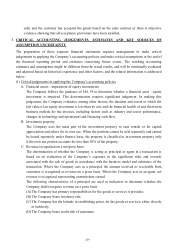 243
243 -
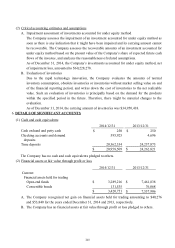 244
244 -
 245
245 -
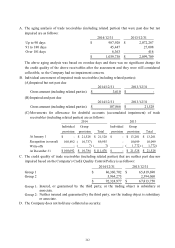 246
246 -
 247
247 -
 248
248 -
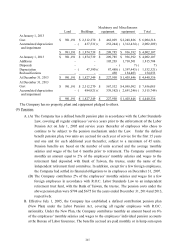 249
249 -
 250
250 -
 251
251 -
 252
252 -
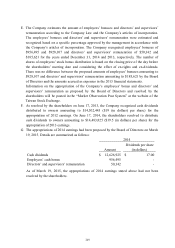 253
253 -
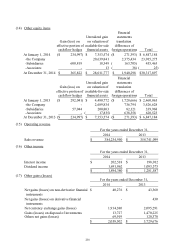 254
254 -
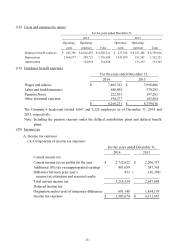 255
255 -
 256
256 -
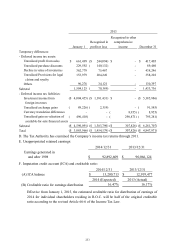 257
257 -
 258
258 -
 259
259 -
 260
260 -
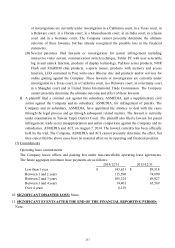 261
261 -
 262
262 -
 263
263 -
 264
264 -
 265
265 -
 266
266 -
 267
267 -
 268
268
 |
 |

247
Depositary may issue new GDRs in proportion to GDRs holding ratios or raise the
number of shares of common stock represented by each unit of GDR or sell stock
dividends on behalf of GDR holders and distribute proceeds to them in proportion to
their GDRs holding ratios.
C. Treasury shares
(A) To enhance the Company’s credit and shareholders’ equ it y, t he Company reacquired its
treasury shares. During the period from July 2, 2013 to August 20, 2013, the shares
reaquired were 10,000,000 shares, amounting to $2,525,987. All of the treasury shares
had been retired on November 21, 2013.
(B) Pursuant to R.O.C. Securities and Exchange Law, the number of shares bought back as
treasury shares should not exceed 10% of the number of the Company’s issued and
outstanding shares and the amount bought back should not exceed the sum of retained
earnings, paid-in capital in excess of par value and realized capital surplus.
(C) Pursuant to R.O.C. Securities and Exchange Law, treasury shares should not be pledged
as collateral and the shareholder’s rights should not be enjoyed before transfer.
(D) Pursuant to R.O.C. Securities and Exchange Law, treasury shares should be transferred
to the employees within three years from the reacquisition date and shares not
transferred within the three-year period should be retired. Treasury shares to enhance
the Company’s credit and the shareholders’ equity should be retired within six months
from the reacquisition date.
(12) Capital surplus
Pursuant to R.O.C. Company Law, capital surplus arising from paid-in capital in excess of par
value on issuance of common stocks and donations can be used to cover accumulated deficit or
to issue new stocks or cash to shareholders in proportion to their share ownership, provided that
the Company has no accumulated deficit. Further, R.O.C. Securities and Exchange Law requires
that the amount of capital surplus to be capitalised mentioned above should not exceed 10% of
the paid-in capital each year. Capital surplus should not be used to cover accumulated deficit
unless the legal reserve is insufficient.
Difference between Changes in
proceeds from associates and joint
acquisition or disposal
ventures accounted
of subsidiary and for under
Share premium book value equity method Total
At January 1, 2014 4,227,966$ 227,466$ 3,195)($ 4,452,237$
Effect of changes in - 942)( 1,462 520
percentage of
ownership
At December 31, 2014
4,227,966$ 226,524$ 1,733)($ 4,452,757$
